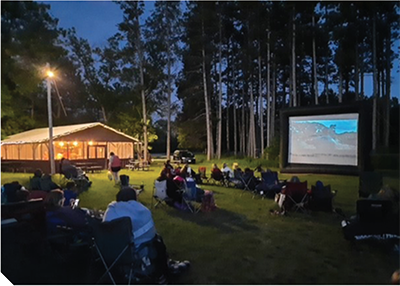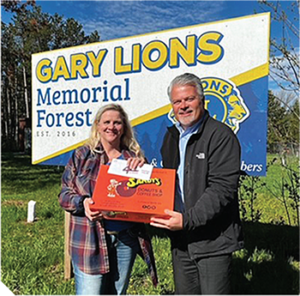City of Gary Reimagines 160 Acres of Forest
By Janet Cass

Your city gets a gift of 160 acres of treeless dirt during the Dust Bowl. What do you do?
This was the question facing the City of Gary (population 232) in northwestern Minnesota. The state donated the land in the 1930s with the expectation that the city would plant trees to help combat the era’s loss of soil. By the end of 1942, the city had a pine forest but not the resources to maintain it. Nor did it have an overarching vision for it. Until recently.
Dreaming bigger
In 2014, the city received a $8,400 Firewise grant from the Minnesota Department of Natural Resources/ Division of Forestry for Gary Pines, or the Pines, as the acreage had become known. The grant was used to clear logging debris and brush and create access for fire-response vehicles, trails, and firebreaks.
This inspired the city to dream bigger and to give its dream a name: Get Out & Play. This would be its campaign to create a multi-use recreational haven within the Pines. The city created a committee to spearhead the process, which got busy applying for grants.
In the spring of 2016, the city secured $8,000 from the University of Minnesota Community Assistantship Program. The grant allowed the city to enlist University of Minnesota design professor Virajita Singh and her graduate student Maxwell Dickson, in consultation with Linda Kingery of the Northwest Regional Sustainable Development Partnership (NRSDP) and others, to create a master plan for the Pines.
Dickson developed proposals that featured six miles of trails, campground sites, obstacle courses, and more. He convened three community meetings during the year to present ideas and solicit feedback.
By December, he had developed three viable plans that were displayed in public places so residents could put stickers on the ideas they preferred. Once Dickson combined favored choices into a final plan, he handed off to the Gary Pines Committee — comprised of community volunteers who reported to the City Council — to pursue funding to implement the plan.
Support came from a wide variety of sources, including Shock & Awe, NRSDP, and the Dekko Foundation, which led the way with a $30,000 grant. The city even received an $8,000 Northwest Minnesota Arts Legacy grant for an art installation of chainsaw statues, just in time for Gary Days in the spring of 2018.
A Pines success
To this day, the community seems thrilled. Trails are shared without incident by horses, bikers, hikers, and motorized vehicles, including all-terrain vehicles and wheelchairs.

Former mayor Karie Kirschbaum notes that the obstacle course is particularly popular, both with children, who love racing through it for fun, and area sports teams, who love racing through it for exercise.
And the ongoing costs have been minimal. Mayor Buck Engen says that volunteers do most of the maintenance, with community groups conducting raffles to cover costs and the Gary Lions Club looking after Lions Memorial Forest and the picnic shelter. Multi-use trails haven’t raised city insurance costs, and firebreaks haven’t lowered them. In fact, the firebreaks proved their worth in 2018 by containing wildfire, making it easier to extinguish.
Meeting challenge, reaping reward
Recalling what it took to bring the idea to fruition, Brian Chisholm, who served on the Gary Pines Committee, says the biggest hurdle was allaying fear. “There were concerns that the project [might] result in damage to property. General fears of change.” That’s where those community meetings proved so valuable.
The Dekko Foundation is pleased with its investment. Earlier this year it chose the project as a top 10 grantee of the past 40 years, and awarded it a second donation, this one for $4,000. The award is funding development of phase three of the ever-evolving campaign, which will include outdoor classrooms, bus parking, signage, and ADA-compliant trails.
Not every city can have as charming an opportunity as Gary did. But every city can strive to make open-space improvements. And Gary’s experience comes with tangible takeaways, according to committee member Chisholm. “Involve the community in all aspects of the project, from planning to implementation,” he says. “Gather as much information from your residents as possible and communicate your project goals and plans. Be transparent.”
Then get out there and play.
Janet Cass is a freelance writer/editor.

